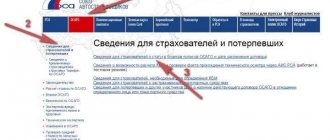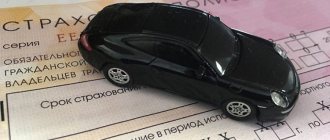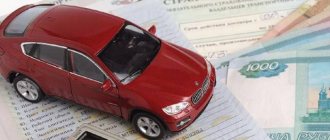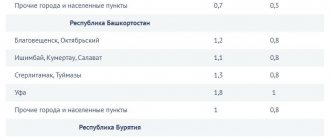What is depreciation?
Depreciation according to OSAGO is the depreciation of vehicle spare parts received during its operation. This parameter is used by insurers to reduce payments under insurance policies and is legal. The thing is that in the event of an accident, most of the car’s spare parts are not new, which means that their market value before the accident is lower than that of a new car (read about how to calculate the cost of spare parts according to compulsory motor liability insurance on the RSA website). As a result, when calculating the insurance payment, insurers do not pay 100% of the average market value of the part, but somewhat less.
Payments under OSAGO
Let's start with the fact that last year a law came into force, due to which the payment of compulsory motor liability insurance, taking into account wear and tear, now in 2021, is intended only for certain categories of victims (physically injured as a result of a car accident, with the complete destruction of a vehicle, etc.).
For other car owners, wear and tear values under compulsory motor liability insurance are not taken into account, since the vehicle is automatically sent for repair. Having sent for repairs, the insurance company pays the cost of all work, including completely new spare parts and wear and tear of spare parts does not matter.
If you belong to the category of drivers who were not guilty of an accident and are entitled to compensation, then you need to calculate the depreciation of the car that was involved in the accident. Depreciation under compulsory motor liability insurance is a priority parameter that affects the amount of payment in the future.
In simple words, car wear and tear is a percentage that is obtained by calculating the age, mileage of the vehicle and other indicators. That is, this is a kind of wear and tear of the car, which inevitably occurs during its operation.
Legislative regulation for insurance companies
The legality and legality of wear and tear under compulsory motor liability insurance is regulated by two legislative documents:
- Article No. 12 of Federal Law No. 40, as amended in 2017, which introduces the concept of mandatory “motor citizenship”.
- Chapter No. 9 of Government Resolution No. 263, which regulates compulsory car insurance. The amount of accrued depreciation is regulated by another document: Appendix of the Central Bank of Russia No. 432-P. This document was adopted in 2014. The described method of calculating depreciation under MTPL is mandatory for use by insurers, their employees and independent expert appraisers.
A working way to receive payment without wear and tear
If what is written above is a little complicated, then we will explain it with a simpler example, which is essentially the simplest possible way to receive such compensation under compulsory motor liability insurance.
- You contact the insurance company after an accident for compensation for damages with the necessary set of documents.
- In your application, you do not specify the method of compensation.
- The insurer, within the allotted 20 days, makes a payment in money to your account, taking into account wear and tear.
- Since (if) there were no grounds for payment, the insurance company was obliged to issue a referral for repairs, and in this case, the calculation should have been made without taking into account wear and tear.
- Accordingly, according to the law, when paying, the calculation must also be without depreciation. But this is only if there were no grounds for monetary compensation.
- Next, a statement of disagreement is submitted to the insurance company with a request to pay the difference between these two calculations. At the same time, there is no need to order an independent examination for a new calculation, because the calculation is already available in the insurance company itself.
- In case of refusal of additional payment, an appeal is submitted to the financial ombudsman.
- And if the finance company’s demands are refused, a claim is filed in court.
We discussed this detailed procedure for appeals (from points 6-8 of the list above) with sample applications in a special article on disagreements with the insurer.
An important drawback of judicial practice
Please note that the above method, based on the Supreme Court’s ruling, can be considered working. However, it is not without its shortcomings, which make the prospect of obtaining a difference in wear not so rosy.
And the point here is in two important subtleties.
- Firstly, in determining the said jurisprudence in 2021, the matter is slightly different. There they were talking about refusal on the grounds that the damage was allegedly received in another accident. And therefore, taking into account your specific case, payment in money without taking into account depreciation may not be awarded at any stage (statement of disagreement, financial ombudsman, court).
- Secondly, and this is the most important thing. The grounds for payment are listed not only in paragraph 16.1 of Article 12 of the Law on Compulsory Motor Liability Insurance. Clause 15.2 of the same article provides another legitimate reason that an insurance company can manipulate for its own benefit.
Clause 15.2 literally says that if the insurer does not have service stations that meet the requirements of the MTPL law (for example, located within 50 km from the accident or the place of residence of the victim or official dealers for cars under 2 years old, and so on). Thus, when you file a claim for extra money without taking into account wear and tear, the insurer can simply point out that it did not have auto repair shops that meet the requirements of the law. Then the basis for payment will be legal, and with it the legality of calculating the amount with wear and tear.
How and by whom is it considered?
A legal calculation of depreciation under compulsory motor liability insurance, which has legal force, can only be data obtained from a certified expert agency, with which the insurance company must necessarily enter into an agreement.
At the same time, you need to understand that in the vast majority of cases, the insurer does not turn to the services of such agencies and calculates depreciation independently. This is not illegal if the insurance company does not issue an official opinion on this issue, but only uses an independent calculation to determine the amount of insurance compensation.
Car wear and tear calculation
The vehicle wear parameter is calculated in several ways:
- The insurance agent orders an examination and assesses the condition of the car.
- The car owner orders an independent examination.
- The owner of a car involved in an accident makes the calculation using an online calculator.
When and by whom is depreciation calculated?
The calculation of wear and tear is carried out by the insurance company after the occurrence of an accident. The insurer sends the car for an expert assessment of the condition of the vehicle and the extent of damage. The owner of the vehicle himself can order the same examination if he is not sure of the company’s calculations. After this procedure, one of the compensation methods is selected:
- cash payment;
- direction for repair.
Attention. In fact, repairs may cost more, and the driver himself will pay the difference.
Which parts are not subject to wear?
Wear and tear applies only to replaceable parts and spare parts. If the parts can be restored during repair, then the insurance payment is made without taking into account wear and tear.
But depreciation is not accrued for some types of equipment, the list of which is legalized and is an addition to Federal Law No. 40 (as Appendix No. 7 from the Bank of the Russian Federation). These elements include the following:
- airbag parts;
- fastenings and seat belts;
- hydraulic system;
- signaling;
- air brakes;
- speakers and acoustic installations;
- brake fault indicators;
- steering gear;
- coupling device, etc.
The full list contains equipment that, if damaged, requires the vehicle to be taken out of service rather than restored.
Methodology, formula and step-by-step calculation procedure with example
At the legislative level, a unified methodology for calculating car depreciation has been adopted. It is used by insurance companies and online calculators. The calculation formula is as follows:
Depreciation of a vehicle under compulsory motor liability insurance (parts, assemblies, assemblies) is calculated using the following formula:
where: Iki - wear of a component (part, assembly, unit) (percent); e – base of natural logarithms (e ≈ 2.72); ΔT is a coefficient that takes into account the impact on wear of a component (part, assembly, unit) and its service life; Tki – service life of a component product (part, assembly, unit); ΔL is a coefficient that takes into account the influence on the wear of a component (part, assembly, unit) of the mileage of the vehicle with this component; Lki – vehicle mileage as of the date of the traffic accident.
The values of the coefficients ∆T and ∆L for various categories and brands of vehicles are given in Appendix 5 to this Calculation Methodology.
For example:
- X = 0.042 (lifetime coefficient) x 5 (direct value) + 0.0023 (mileage coefficient) x 33.5 (direct value) = 0.28705.
- Next, the base of the logarithm e-x (equal to ≈ 2.72) is raised to the power obtained above and it turns out = 0.75033809
- 1 — 0,75033809 = 0,2496619
- 100 x 0.2496619 = 25%
Depreciation is 25%. This percentage applies to any part of the car.
For the online calculator (https://www.osa-spb.ru/kalkulyator-raschjota-iznosa-transportnogo-sredstva.html) the following parameters are used (with example):
- Date of operation – 12/12/2007.
- Date of the accident – 05/20/2019.
- Vehicle category - VAZ.
- Mileage – 530,000 km.
- The result is actual wear and tear of 89.11%, but it should not be higher than 50%, which means the car owner will have to pay extra for repairs personally.
Maximum and minimum values, conditions under which this is possible
Wear depends on the following parameters:
- from maintenance;
- on the quality of lubrication;
- original condition of parts;
- adjusting mechanisms, etc.
Wear of parts increases with the service life of the parts and the amount of work performed. When calculating, a maximum percentage of car deterioration of 50% is allowed. Minimum wear, which is typical for all cars, is 1-10%.
Formula and coefficients
The depreciation of car parts under compulsory motor liability insurance can be calculated independently or using online calculators to calculate insurance payments, taking into account the percentage of depreciation. Each of these methods will be discussed below. So, in order to calculate depreciation on a vehicle license using an online calculator, you will need to enter the following data:
- vehicle release date;
- date when the accident occurred;
- type of vehicle;
- vehicle mileage as of the date of the traffic accident;
- Tire tread height on the date of the accident.
By entering all the above data, you can get the total wear of car parts, wear of the car battery and wear of tires. To calculate the wear and tear of a car yourself, you will have to use the formula that is determined by the unified calculation system established by the Central Bank of Russia.
To calculate wear, you need to raise 2.72 to a power, the value of which is equal to - (ΔT*Tki+ΔL*Lki), where:
- ΔT – coefficient determined by the service life of the machine.
- Tki – years during which the car was operated.
- ΔL – coefficient determined by the vehicle mileage.
- Lki – kilometers traveled by the car.
The resulting value must be subtracted from 1 and multiplied by 100 .
The resulting value will show the wear of parts as a percentage.
The parameters ΔТ and ΔL deserve special attention. Their values must be determined from the table below.
| Type of vehicle | ΔT value | ΔL value |
| VAZ, UAZ, GAZ, TagAZ, ZAZ | 0,057 | 0,003 |
| Brilliance, BYD, Chery, Derways, FAW, Geely, Great Wall, Hafei, Haima, Lifan, Luxgen, Xin Kai | 0,057 | 0,0029 |
| Aston Martin, Bentley, Bugatti, Ferrari, Jaguar, Maserati, Porsche, Audi, BMW, Mercedes-Benz, Mini, Rover Alfa Romeo, Citroen, Fiat, Ford, Opel, Peugeot, Renault, Saab, SEAT, Skoda, Volkswagen, Volvo | 0,042 | 0,0023 |
| Acura, Buick, Cadillac, Chevrolet, Chrysler, Dodge, Hummer, Infiniti, Jeep, Lexus, Lincoln, Mercury, Pontiac | 0,045 | 0,0024 |
| Daewoo, Hyundai, Kia, Ssang Yong, | 0,052 | 0,0026 |
| Toyota, Mitsubishi, Daihatsu, Honda, Isuzu, Mazda, Nissan, Subaru, Suzuki, | 0,049 | 0,0025 |
| Freight vehicles | 0,077 | 0,0023 |
| Buses | 0,113 | 0,0008 |
| Trolleybuses and trams | 0,098 | 0,0008 |
| Trailers for trucks | 0,09 | 0 |
| Trailers for cars | 0,06 | 0 |
| Motorcycles | 0,07 | 0 |
| Agricultural, fire, construction and other special equipment | 0,15 | 0 |
The full formula for calculating compulsory motor liability insurance and a table of all coefficients can be found in this material.
Calculation method and formula
The law provides for a special method for calculating vehicle depreciation.
The following formula applies:
- IKI - wear of a part, mechanism, part of a car.
- e – 2.72 (base of natural logarithms).
- ΔT is a coefficient that takes into account the effect on wear of an element from the total duration of its use.
- TCI – duration of use of a worn element.
- ΔL is a coefficient that takes into account the impact on the wear of an element of the overall mileage of the car with this element.
- LKI is the total mileage of the car at the time of the car accident.
Article on the topic: Peculiarities of driving a car with expired MTPL insurance
The sizes of the coefficients ∆T and ∆L for different models and types of cars are reflected in Appendix 5 of Federal Law No. 40.
As an example, let's take a 2010 Honda car that was involved in an accident in 2021, with a mileage of 100,000 km. As a result of using the above formula, the actual wear and tear of such a car is 49.89%.
On specialized websites you can use depreciation calculators to independently calculate the amount of payment due for a damaged car under compulsory motor liability insurance. It is important to understand that in such calculators the calculations are approximate, but the final results should not differ greatly from those that will be presented by the expert organization.
Can additional coefficients be added to the formula?
Yes, insurance companies and expert organizations working with them often add additional coefficients to the formula for calculating depreciation, which further reduce the size of the final payment under compulsory motor liability insurance.
The use of such coefficients is usually possible if the following factors are present:
- excessively severe corrosion of metal elements of the car, not typical for a specific part;
- presence of damage to the body part and paintwork of the car that is not related to the insured event;
- presence of traces of repairs that were carried out with technological violations;
- old paint defects;
- the presence of repair inserts, cuts when restoring components;
- the presence of serious external defects: abrasions on the glass, cracks, chips and other defects on the headlights and lighting equipment.
Which car parts are subject to accrual and which are not?
Depreciation under compulsory motor liability insurance is charged on all vehicle spare parts, except for the list specified by law. This list includes the following:
- Airbags for driver and passengers.
- The seat belt and all its components.
- Components and assemblies of pneumatic, electronic-pneumatic and hydraulic brake systems.
- Steering wheel control components and assemblies.
- Components and assemblies of the vehicle clutch system.
What wear and tear does not apply to
The law provides for a small list of elements, components and components of vehicles that could potentially be damaged as a result of an accident; in this case, the insurance company and experts do not have the right to calculate the level of wear, regardless of the year of manufacture of the car and other factors.
These elements of cars are:
- any airbag parts;
- alarm equipment;
- hydraulic systems in cars (any);
- seat belts (all elements of the mechanism);
- installed acoustics;
- brake system malfunction sensors;
- steering wheel and all related parts;
- clutch and a number of other elements.
A complete list of details can be found in Appendix 7 to Federal Law No. 40. The cost of restoring such elements is calculated without taking into account depreciation.
What to do if the insurance company underestimates payments?
Cases where insurers overestimate the wear and tear of parts are not uncommon. This is due to the fact that the goal of any player in the insurance market is to make a profit , whatever they say in their advertising. Unfortunately, practice shows that in negotiations with the policyholder, the insurer does not accept arguments regarding the incorrect calculation of wear and tear. The only option left to the policyholder is to go to court.
But there is one serious pitfall: the lawsuit will have to be accompanied by a conclusion from a certified company that is allowed to conduct such examinations, and these are additional costs, which, if won, will fall on the shoulders of the insurance company, and if the claim is not satisfied, will remain additional costs for the insured.
Please note: After filing an application with the court, a hearing will be scheduled at which the judge, after listening to the opinions of the parties, will order a third examination at the Chamber of Commerce and Industry or a similar government agency.
It is on the basis of the conclusions of these experts that a verdict will be rendered on the claim for review of wear and tear under OSAGO. In general, depreciation under compulsory motor liability insurance is a variable that has an exact calculation formula, which does not prevent insurers from trying to deceive policyholders by overstating depreciation or applying it to parts to which it cannot be applied by law.
Therefore, every vehicle owner needs to understand the depreciation formula so that he can check the correctness of the calculation of this variable and, if necessary, go to court to restore justice.
In order to be sure of the correct calculation of insurance and payments for it, we suggest that you familiarize yourself with the following information:
- tariffs for compulsory motor liability insurance and its calculation;
- how to calculate an electronic MTPL policy using an online calculator;
- driver class and its impact on the cost of insurance;
- how to calculate the loss of marketable value of a car;
- how to calculate the amount of payment under compulsory motor liability insurance in case of an accident;
- how to calculate damage using the RCA database.
Law on wear and tear of vehicles under compulsory motor liability insurance
Depreciation for compulsory motor liability insurance is discussed in the “Insurance Rules”, which were approved by the Central Bank of Russia. In particular, it says the following: “The insurance company, when determining the amount of costs for restoring a car, is obliged to take into account the wear and tear of parts, mechanisms, electrical equipment and other elements of the car. The amount of expenses for spare parts should be established taking into account the wear and tear of components that are subject to replacement during the process of restoration and repair work. Moreover, component parts cannot be subject to depreciation of more than 50% of their original cost.
Related article: Total loss of a car under compulsory motor liability insurance policy
Who does the calculation and how?
Inspecting the technical condition of the car after an accident, taking into account the degree of actual wear before the accident, is the task of the insurer.
The insurance company must determine the cost of restoring the car under compulsory motor liability insurance with subsequent compensation for repairs or cash payment to the owner.
Therefore, the insurer needs to initiate an examination of the car, determining:
- actual condition of the vehicle before the accident;
- list of defects and damage received during an accident.
The examination is carried out with the participation of the owner. If the client does not agree with the conclusions of the experts engaged by the insurer, he can organize an independent examination.
Calculation of the level of deterioration of a car is carried out by experts of the insurance organization, according to methodology No. 431-P approved by the Central Bank of the Russian Federation in September 2014. The percentage is determined taking into account:
- passport date of start of operation of the machine;
- the date of the incident, recorded in the documentation drawn up by the traffic police based on the results of the investigation of the accident;
- car models;
- mileage based on odometer data;
- wear level of tire tread height, tire service life;
- the quality of previously carried out repairs, if any;
- technical features of the element and other circumstances.
The listed factors are taken in the form of correction factors, the consideration of which affects the calculated value in the formula.
The prices of parts for compulsory motor liability insurance are calculated according to the RSA directory, which is uniform for all insurers.
How to calculate the cost of car repairs under OSAGO
The cost of restoration repairs is calculated based on the results of an independent examination carried out by a specialized organization.
The expert's report must reflect:
- the reason for conducting the study;
- date of vehicle inspection;
- name of the company conducting the inspection;
- information about the owner of the vehicle under study;
- individual characteristics of the car (make, model, number, year of manufacture, year of commissioning, equipment, etc.);
- information about the damage received;
- Determining possible troubleshooting solutions;
- information about car defects received before the accident;
- whether the damage was a result of a road accident;
- information about possible hidden damage;
- date of document preparation.
Photographs may be attached to the inspection report to prove certain facts.
Calculation of the cost of repairs, after an examination, is made using a unified methodology and a special formula.
How to check an OSAGO insurance policy by number is shown in the article: check an OSAGO insurance policy by number. Read about MTPL tariffs by region here.
By what method
Currently, the cost of calculation is made according to a unified methodology developed by the Union of Auto Insurers and approved by Central Bank Regulation No. 432-P.
The methodology defines all stages and criteria for assessing the cost of repairs and is mandatory for all insurance companies and organizations conducting an independent examination.
In accordance with the developed document:
- the cost of repairs is determined on the date of the accident and taking into account regional boundaries. That is, the cost of repairing the same element may differ on different days and in different cities;
- When determining the cost of repairs, the wear and tear of the vehicle and individual units that are subject to restoration are taken into account. The maximum depreciation amount for 2021 is 50%.
Formula
To independently calculate the cost of restoration repairs, you can use the following formula:
Wed = Rpr+Rm+Rzch,
Where
| Wed | total cost of repair (required value) |
| Rpr | expenses associated with car repair work |
| Rm | expenses necessary to purchase materials |
| Rzch | costs associated with the purchase of spare parts |
The amount of expenses for the purchase of spare parts (Rzch) is determined by the formula:
| m | quantity of spare parts required for a complete repair |
| To | number of units of one part to be replaced |
| WITH | cost of one part |
| AND | part wear |
The cost of materials is determined by the following formula:
| n | number of types of materials required for repairs |
| WITH | unit cost of one type of material |
| N | consumption rate of a certain type of material |
| TO | number of parts that need to be repaired using a certain type of material |
The costs of repair work are determined using a special reference book.
Example
It is quite difficult to independently apply the formulas given in a unified methodology to calculate the cost of repair work.
Therefore, the RSA website has a special form that allows you to determine all the parameters in a few simple steps. It is the information from the RSA website that will be given as an example.
For example, to repair a car you need:
- paint the rear bumper. The cost of the work is 550 rubles. It will take 0.9 standard hours to complete. That is, the real cost of the work will be 550 * 0.9 = 495 rubles ;
- paint the back door of the car. The cost is 550 rubles, but it takes 1.6 standard hours. We get 550 * 1.6 = 880 rubles ;
- Preparation for painting the door is estimated at 500 rubles, but completion requires 0.5 standard hours. The cost of the work will be 500 * 0.5 = 250 rubles ;
- Preparation for painting the bumper according to the reference book is estimated at 450 rubles and 0.5 standard hours, that is, it will be 450 * 0.5 = 225 rubles ;
- the unit needs to be replaced at a cost of 2,700 rubles (the cost is taken into account wear and tear);
- the work to replace the unit will cost 3,000 rubles .
Thus, the total cost of restoration repairs will be:
495+880+250+225+2700+3000 = 7,550 rubles.











